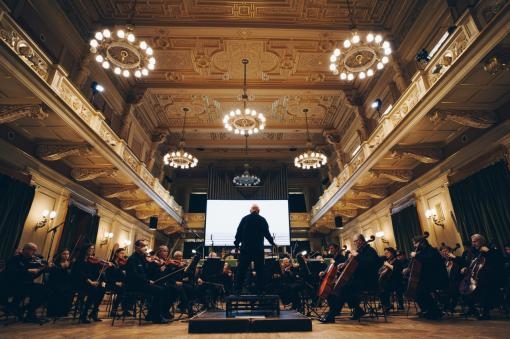The fourth subscription evening prepared by the Brno Philharmonic for the chief conductor's series called Philharmonic at Stadion and Janáček Theatre is an exceptional dramaturgical feat. The programme entitled "Pictures at an Exhibition", based on Modest Petrovich Mussorgsky's initial composition, combines additional works originated in and inspired by painting: The Frescoes of Piero della Francesca by Bohuslav Martinů, and Mathis der Maler, a symphony by Paul Hindemith. Sounding painting is accompanied by unique, music-illustrated visualisations of Cori O’Lan in collaboration with Ars Electronica. This week's difficult situation, not only for cultural institutions, was managed by the Brno Philharmonic promptly and with a great acclaim. Much like Cirk La Putyka on the day before, the Philharmonic decided not to cancel the performance at the Janáček Theatre and to broadcast the music and visualisations on 12 March from the Besední dům live on the web and on social networks.
In case the listeners were not disrupted by connection problems or the quality of their loudspeakers, it was, within possibilities, an adequate replacement for the live performance. The impoverished two-dimensional perception was made up for by the camera focusing on musicians and, above all, first-class sound quality. Microphones and computers were used to create the orchestra-responsive visualisations, transmitting and modifying the sound of music, and the result was an almost studio sound, balanced and sensitively enhanced. The traditionally friendly acoustics of the Besední dům was also a plus.
Pictures at an Exhibition (also known as Kartinky) by Modest Petrovich Mussorgsky were created in 1874 under the impression of an exhibition of Viktor Hartman, an artist close to the Mighty Five (New Russian School). What originally had been a mere piano cycle of ten "pictures" was now performed by the Philharmonic in a colourful instrumentation written by the master of Impressionism Maurice Ravel in 1922. However, the accompanying visualization was figurative or narrative only to a minimum extent. Mostly abstract objects responded to the momentary qualities of the music being played (its volume, rhythm and frequency); on the other hand, the visualisation not always matched the colour of the sound, meaning the exposure of individual instruments. Here I see the drawbacks of technical sound processing, which does not correspond to the intuitive impression of the listener, who usually perceives the changing colours all the time. This visualization, only little concrete, as opposed to illustration, enhanced the absoluteness of music, directed people's attention to its loose flow not streamlined by meaning, and in places this organic connection was almost meditative. The closing part The Bogatyr Gates had all the breadth and satisfactory fullness of sound, consistent with the pompousness and sparkle of Ravel's instrumentation.
In the composition of The Frescoes of Piero della Francesca H 352 by Bohuslav Martinů, Cori O’Lan opted for a different approach and chose the frescoes from the Church of St. Francis in Arezzo rather than just a partial abstraction. In 1954, they inspired Bohuslav Martinů, who in his three-movement suite for a big orchestra, completed in the spring of 1955, shares his impression of these paintings of the Italian Quattrocento (The Annunciation and The Legend of the True Cross from 1455–1466). Alongside the Fantaisies symphoniques, Incantations and The Parables, the Frescoes rank among the rhapsodic and fantasy works of the composer's peak creative period, where the form is relaxed in favour of the program, impression or colour.
The visualisation initially enters the role of a viewer and evokes the illusion that we observe the frescoes ourselves – through a limited image section, focusing, eye tracking camera and peripheral vision. Impressive were the close-ups, very dramatic and suggestive, again in a way replacing the necessarily limited physical experience. The second movement Adagio refers to a part of the drawing Constantine's Dream: the frescoes are shrouded in darkness and illuminated by a spotlight, and the image is at the same time permeated by letters or the represented musical form. According to the composer, the third movement Poco allegro is supposed to be a general impression of the frescoes, the visualisation here relaxes, gets multilayered and spreads into a colour palette. The evocation of history culminates in a kaleidoscopic portrait of Piero della Francesca.
In addition to numerous responses and comments on social networks, this was testified by some 16 thousand virtual spectators on Thursday evening, whose number during the one-hour programme practically did not decrease. The synthetic potential of a screen took over in many ways here, and the resolute performances and commitment of the artists could be conveyed to a really broad audience in appropriate quality. There is no choice but to contradict ourselves and hope that this very successful attempt will not become a standard. Due to the great acclaim, the concert was repeated on Friday, too.
Pictures at an Exhibition
4th subscription concert of the series Philharmonic at Stadion and Janáček Theatre, 12 and 13 March 2020
Modest Mussorgsky/ arr. Maurice Ravel
Pictures at an Exhibition
Bohuslav Martinů
The Frescoes of Piero della Francesca H 352
Paul Hindemith
Mathis der Maler, a symphony
Brno Philharmonic
conductor Dennis Russell Davies
visualisations by Cori O’Lan (Ars Electronica)
































No comment added yet..